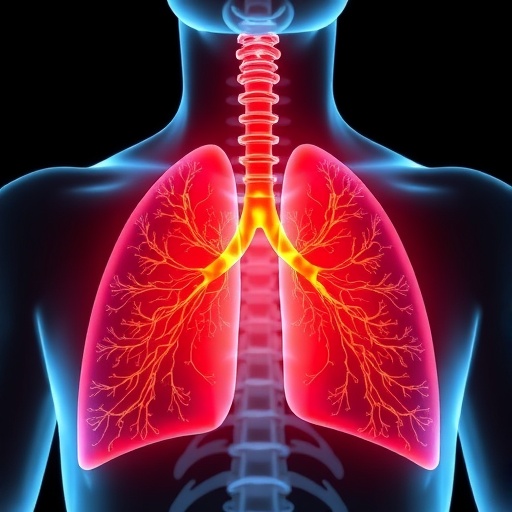In a groundbreaking commentary published in the Journal of Translational Medicine, authors Luo and Chen delve deeply into the intricate relationship between heavy metals, lung function, and airway inflammation, as revealed by a recent population-based study. This review not only sheds light on the alarming effects of environmental pollutants on respiratory health but also emphasizes the urgent need for more comprehensive research in this vital area. As air quality continues to decline in many urban regions across the globe, understanding the impact of heavy metals on lung physiology becomes increasingly paramount.
The broad spectrum of respiratory diseases linked to the presence of heavy metals in the environment cannot be overlooked. Previous studies have established a correlation between air pollution and a variety of respiratory conditions, including asthma, chronic obstructive pulmonary disease (COPD), and lung cancer. The statistics are alarming: over a million premature deaths annually are attributed to outdoor air pollution, with heavy metals being among the most dangerous constituents. Luo and Chen’s commentary synthesizes existing literature, reinforcing the critical notion that exposure to heavy metals could exacerbate these conditions by influencing both lung function and inflammatory responses in the airways.
According to current research, among heavy metals, lead, mercury, arsenic, and cadmium have been identified as particularly concerning. These metals can accumulate in the body over time, leading to chronic health issues. Inhaling airborne heavy metal particles can provoke oxidative stress and inflammation in lung tissues, consequently impairing respiratory function. The commentary emphasizes that this nuanced mechanism should not be underestimated when tackling public health policies aimed at cleaner air initiatives.
Moreover, the study referenced by Luo and Chen provides insights into the demographic variables that may affect susceptibility to heavy metal exposure. Factors such as age, gender, socioeconomic status, and pre-existing health conditions can influence individual vulnerability. For instance, children and the elderly have been observed to be more susceptible to the detrimental effects of inhaled heavy metals due to their developing or already compromised pulmonary systems. By outlining these variables, Luo and Chen elevate the conversation about tailored public health recommendations that could better protect at-risk populations.
Another noteworthy aspect of the discourse revolves around the concept of cumulative exposure. Individuals living in areas with high pollution levels often encounter heavy metals alongside a cocktail of other harmful pollutants. This situation complicates the assessment of lung health outcomes since the effects of multiple exposures are not fully understood. The authors assert that future research should encompass multi-pollutant exposure scenarios to provide a more accurate picture of the health risks posed by heavy metals in the air.
The commentary further touches on the inadequacy of existing air quality standards, which often overlook the detrimental effects of heavy metals. Regulatory bodies must re-evaluate acceptable limits for heavy metals in air quality guidelines to account for their extensive impact on health. Luo and Chen advocate for stringent environmental regulations that would not only target particulate matter but also address the chemical composition of airborne pollutants.
Scientific collaborations across disciplines are crucial in unraveling the complex interrelations between heavy metals and respiratory health. The commentary urges researchers from fields such as toxicology, environmental science, and pulmonology to work hand-in-hand in documenting the impact of metal exposure on lung function. Such interdisciplinary efforts could lead to innovative approaches for monitoring and mitigating exposure levels in vulnerable communities.
Highlighting the proactive role of municipalities in combating pollution, Luo and Chen provide examples of successful initiatives focused on reducing heavy metal emissions from industrial sources. These local governments have employed measures such as stricter licensing for factories, real-time monitoring of air quality, and public awareness campaigns to engage communities in monitoring their air quality. Demonstrating the efficacy of these initiatives could inspire similar actions worldwide.
Community engagement plays a pivotal role in mitigating the impact of heavy metals on air quality. The commentary identifies that raising awareness about the health risks of environmental pollution empowers individuals to demand change. Schools, community centers, and local organizations can become hubs for education about the impacts of heavy metals, providing residents with tools to advocate for improvements in air quality.
Luo and Chen also discuss the need for targeted interventions aimed at communities identified as high-risk due to heavy metal exposure. This includes establishing clean air zones, green spaces, and public transportation initiatives. These interventions can reduce overall pollution levels while also enhancing community health and well-being. Funding such programs, however, requires commitment from both public and private sectors.
The global aspect of heavy metal pollution necessitates international cooperation and knowledge sharing. Luo and Chen highlight that the problem transcends borders, with many countries struggling with the effects of industrial pollution. Collaborative efforts are needed to develop global action plans aimed at reducing emissions of heavy metals and improving air quality worldwide.
In summary, the commentary from Luo and Chen serves as an urgent reminder of the significant health implications posed by heavy metals in our environment. Their insights extend beyond mere commentary; rather, they call for a concerted effort across multiple fronts—research, regulation, community engagement, and international collaboration—to battle the rising tide of respiratory diseases linked to pollution. The interconnectedness of environmental quality and public health underscores the necessity of prioritizing clean air initiatives, especially in light of the ongoing environmental challenges we face.
Efforts to safeguard lung health require unwavering dedication from researchers, policymakers, and public health advocates. By addressing the multifaceted dimensions of heavy metal exposure and its consequences on respiratory function, we take meaningful steps toward a healthier future. As we continue to explore the complexities of environmental health, the need for action has never been clearer, nor the potential rewards more substantial.
In a world increasingly aware of the importance of clean air, Luo and Chen’s commentary serves not just as a reflection on current understanding but as a clarion call to action. Awareness of the hazards posed by heavy metals is essential as we push for solutions that prioritize the health of our lungs and our communities.
Subject of Research: Heavy metals and their relationship with lung function and airway inflammation.
Article Title: Comments on “heavy metals and their relationships with lung function and airway inflammation: insights from a population-based study”.
Article References: Luo, T., Chen, T. Comments on “heavy metals and their relationships with lung function and airway inflammation: insights from a population-based study”. J Transl Med 23, 977 (2025). https://doi.org/10.1186/s12967-025-06999-x
Image Credits: AI Generated
DOI:
Keywords: Heavy metals, lung function, airway inflammation, air quality, public health, environmental pollution, respiratory diseases.
Tags: air quality and respiratory diseasesasthma and air pollutionchronic obstructive pulmonary disease and heavy metalsenvironmental pollutants and respiratory healthheavy metals and lung functionimpact of heavy metals on airway inflammationlung cancer risk factorspopulation-based study on air pollutionpremature deaths from air pollutionrelationship between heavy metals and inflammationurban air quality declineurgent need for research on heavy metals





